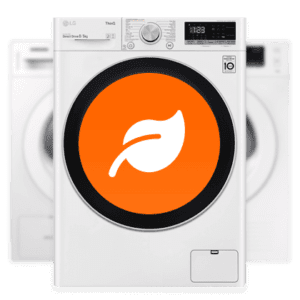Can you wash and dry energy efficiently with a washer/dryer combi?
A washer/dryer combi has many advantages. Especially if you have limited space it is very convenient to have a washer and dryer all in one.
In addition, some washer-dryers are also equipped with a non-stop function, allowing you to wash and dry in one go. This is particularly handy when you’re not at home all day. You put your laundry in the machine in the morning and when you get home in the evening you only have to fold it and put it away.
This is one of the reasons why washer-dryers are becoming increasingly popular and why manufacturers are investing in making them more energy efficient. Now you can also buy a washer-dryer with a heat pump, which uses up to 40% less energy than the normal model. It is classified in energy class a, which is the highest achievable. You do have to take into account that you will pay about 300 more for this model. On a yearly basis, this model will save you around 100 on your energy costs, which means that it will take about 3 years to pay for itself.
Best energy efficient washer-dryers of 2024
Are you looking for a new washer-dryer and is your main requirement that it is energy efficient? Then it’s definitely worth taking a look at this selection. Not only are they tested on the energy label, but you can also find out what the drum fill weight for both washing and drying is, what different drying and washing programmes there are and what the water consumption is.
Energy labels washer-dryers explained
If you want to know something about how energy efficient your washer-dryer is, you should look at the energy label. In this section we’ve listed what information you can find on the energy label and what that information means.
A energy label for your washer and dryer
Since March this year, every washer and dryer comes with two different energy labels. One label represents washing and the other represents washing and drying.
The energy rating of a washer-dryer is classified from energy class A to G, with A being the most efficient and G the least.
What information about your energy-efficient washer-dryer can you find on its energy label?
Besides the energy class, you can find a lot more useful information on the energy label of your washer-dryer. Scanning this code with your smartphone will take you straight to a European Union database. Here you will always find the latest technical specifications of your washer-dryer.
Has your washer-dryer been tested recently? If so, you will find all the results below the QR code.
Maximum fill weight
The energy label also shows the maximum amount of laundry that can fit into the drum. If you wash too much laundry at once, you run the risk of not getting it completely clean, and leaving the drum half-empty uses more water and energy than you need.
When buying a washing and drying combination, always make sure that the capacity of the drum is always higher for washing than for drying. For example, if the load capacity is 8kg for washing, chances are that the load capacity is only 5kg for drying. This is because the appliance needs more space for drying than it does for washing.
The Noise Level
Want to know if you can put your washer-dryer near your bedroom? Again, you can refer to the energy label. The volume is always quoted in decibels and is measured when your laundry is being spun.
In general, a washer-dryer with a noise level below 73 is considered quiet. A noise level between 74 and 77 is considered normal, and one above 78 decibels is considered very loud.
Full program duration
Each washer/dryer has several programs, each with a different function. Your energy label will indicate how long it takes for a full load of laundry to come clean.
There are two times indicated for this too, one for washing only and one for washing and drying. The times indicated are always for the eco wash programs at 40 and 60 degrees. These times are usually quite long, but don’t be put off by that, there will be plenty of other wash programs that take less time.
Water consumption
Here you will find how much water your washer-dryer uses in litres per wash cycle. Note that this also shows the water consumption for washing only, but you can also read how much water is used for washing and drying.
Old energy labels
The energy label described above is made according to new European Union regulations, but chances are you already have a washer-dryer that has an old energy label.
By making the requirements for energy label A increasingly strict, manufacturers are motivated to invest more in making their washer-dryers energy efficient. Even if you have a washer and dryer that does not have an energy label A, there are still a number of things you can do to wash and dry the laundry in a responsible way. We’ve listed a few different tips for you here:
1. Don’t use too much detergent
The exact amount needed to wash a full load can always be found on the detergent packaging, but many people still use too much.
As a result, your washing machine has to rinse longer to get all your laundry clean, which can take up to half an hour. This causes you to use much more water than necessary, but also energy.
2. Always wash at the right temperature
Many people are still used to washing their laundry at 40 degrees, because they think that at 30 degrees or less it will not get clean. These days, that wisdom is long outdated and you can get your laundry clean at low temperatures too.
Setting your washing machine to 30 degrees instead of 40 degrees can make a significant energy saving. It depends on which machine you have, but in some cases it can cut energy use in half.
3. Always fill your drum completely
When it comes to both washing and drying, it is always important to make the most of your washer-dryer’s capacity. Is the total load 8kg for washing and 5kg for drying? If so, always make sure you save your laundry until you have enough.
It might seem like a lot, but 8 kg of laundry is easy to put together. For a one-person household, that’s about a week’s worth of clothes.
4. Let your laundry dry naturally
The disadvantage of a combined washer and dryer is that the capacity of the drum is higher for washing than for drying. So choose to dry some of your laundry naturally and not run the dryer twice.
For bedding and towels, it’s great to get them dry quickly, but some delicate garments in particular are better off drying on a rack. This tip will not only save you a lot of energy, but will also help you to be more efficient with your clothes.
5. Choose Eco Mode
Most all wash and dry machines have an eco mode for washing and drying. One of the misconceptions is that people often think the eco-mode is not economical, because it often lasts much longer. The opposite is true, an eco program lasts longer because it uses a low temperature.
With a normal program, most of the energy is used to heat the water, not by the time the appliance is on. So don’t be fooled by the duration of an eco program. Always choose liquid detergent for an eco-program. An eco-program has a considerably shorter runtime, and using powder detergent may not rinse out well.
Would it be better to buy an energy-efficient washer/dryer combination or a separate washer/dryer?
Every household has different laundry needs, so if you want to keep your energy consumption as low as possible, you should think carefully about your situation. If you need a large drum capacity for both washing and drying, it is better to choose two separate appliances. That way, you’ll avoid increasing your energy costs by always having to run extra programs for drying.
Do you not dry a lot of your clothes? Then a washer and dryer in one appliance may be just the thing for you. You use your washer/dryer combination mainly for washing, and you only run the drying programme when you really need to. You’ll use less energy than if you were to buy two separate appliances.
Please also note that some models are available in different variants. The aeg l7wb86gw, for example, has a model with a fill weight of 8kg for washing and 4kg for drying with energy label E, but the same model with a fill weight for washing of 10kg and drying of 6kg has energy label C. The latter model is suitable if you want to use just one appliance for a large household.

